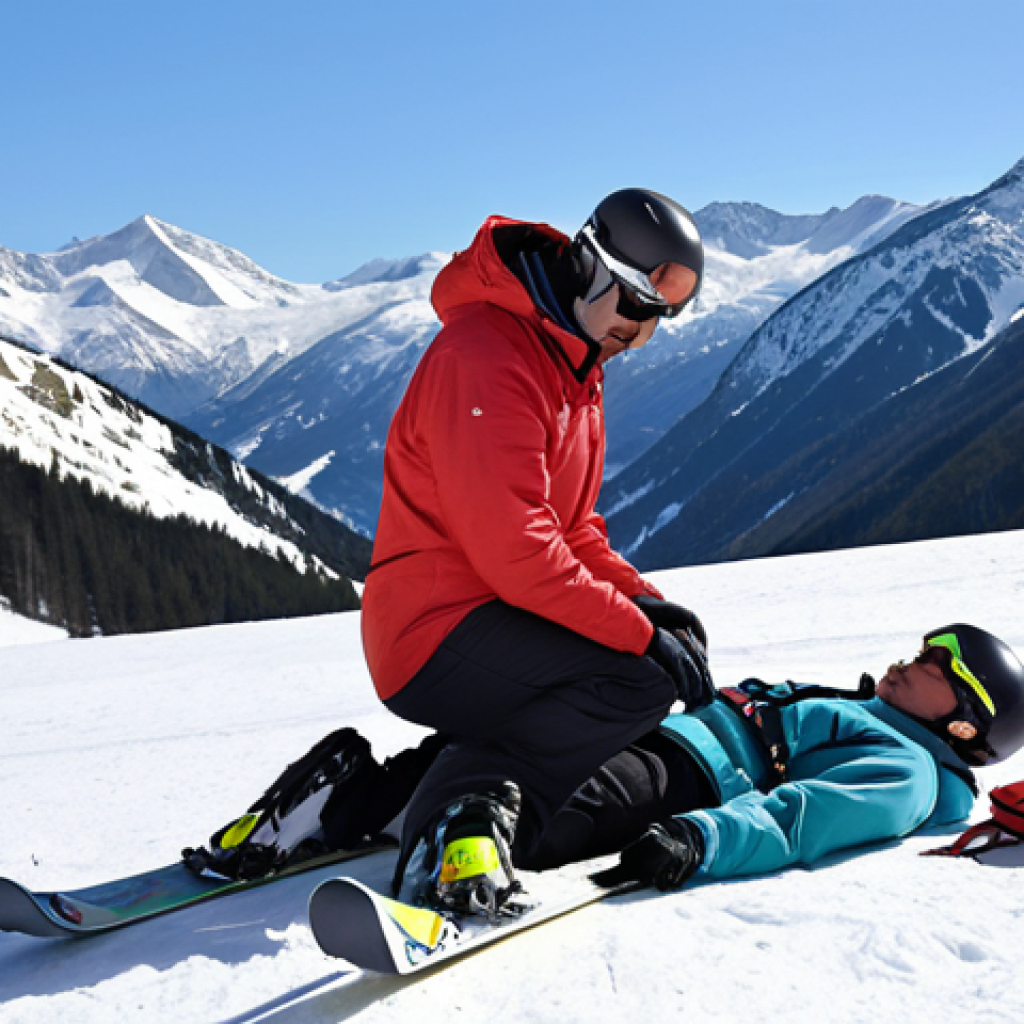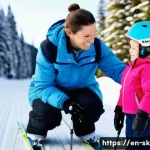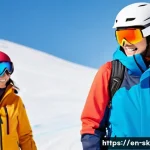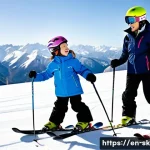Alright, here’s a blog-style intro about practical incident response skills for ski instructors:Picture this: you’re carving down a slope, wind in your face, when suddenly you spot someone ahead struggling to get up after a fall.
Or maybe a blizzard rolls in faster than expected, and guests start panicking. Being a ski instructor isn’t just about teaching technique; it’s about being prepared for anything the mountain throws your way.
From minor mishaps to serious emergencies, knowing how to react quickly and effectively can make all the difference. The slopes are unpredictable, and your quick thinking can truly be a game-changer in ensuring everyone’s safety and well-being.
I’ve seen instructors handle tricky situations with grace under pressure, and that comes down to solid training and a cool head. Let’s delve deeper into the essential skills you need to master!
Okay, here is the blog post content:
Spotting and Reacting to Common Injuries
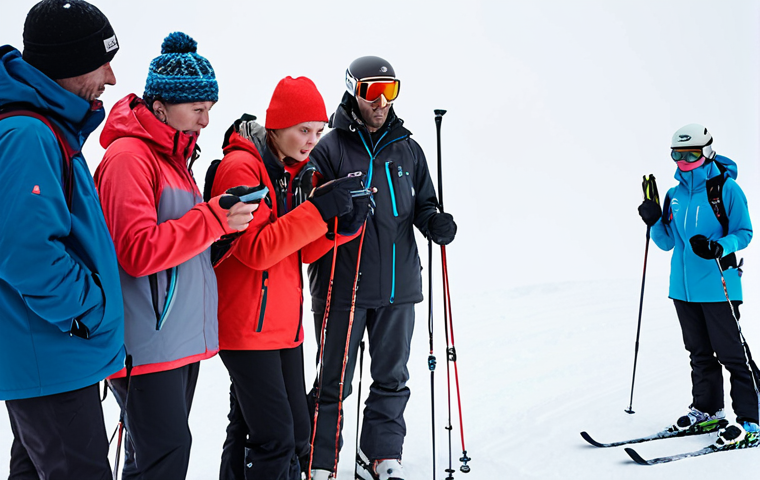
First things first, you’ve got to be able to recognize the common injuries out on the slopes. I’m talking about sprains, strains, fractures, and head injuries. I remember one time, a guest took a nasty fall right in front of me. At first, he seemed okay, just a bit shaken up. But I noticed he was favoring his wrist and his face was starting to pale. Turns out, he had a hairline fracture. The key is to look for subtle signs: swelling, bruising, an awkward angle to a limb, or any change in their level of consciousness. Don’t just ask if they’re okay; really observe them. Check for responsiveness and be extra cautious with kids, because they often don’t immediately express pain. Trust your gut. If something doesn’t feel right, it probably isn’t. That gut feeling has saved many people from further injuries. And always, always prioritize their safety above all else.
Initial Assessment Techniques
Alright, someone’s down. What do you do? You start with a quick but thorough assessment. Approach the person calmly and introduce yourself, let them know you’re there to help. Ask them what hurts and where. Gently check for any obvious deformities or bleeding. Remember the acronym “SAMPLE”:
- Signs and Symptoms: What do you see and what does the person feel?
- Allergies: Any known allergies?
- Medications: Are they taking any medications?
- Past medical history: Any relevant medical history?
- Last meal: When did they last eat or drink?
- Events leading up to the incident: What happened?
This gives you a baseline of information to work with. Getting this information is like piecing together a puzzle. It might not give you the complete picture right away, but it gives you a good starting point.
Basic First Aid on the Snow
Knowing basic first aid is non-negotiable. You need to be able to stabilize injuries, control bleeding, and keep the person warm. Carry a well-stocked first-aid kit with you at all times. I always have one in my instructor bag, and it’s come in handy more times than I can count. Learn how to apply a splint, use bandages effectively, and recognize the signs of shock. Hypothermia is a real threat on the mountain, so know how to warm someone up gradually. Don’t pour hot liquids on them! Use blankets, share body heat, and get them to a warmer place as soon as possible. It’s like being a mountain medic – you’re the first line of defense.
Managing Group Safety in Adverse Conditions
Sometimes, the biggest challenge isn’t a single injury, but managing a whole group when the weather turns sour. I’m talking about whiteouts, sudden temperature drops, or unexpected heavy snow. It happened to me once – we were halfway down a run when a blizzard hit out of nowhere. Visibility dropped to near zero, and panic started to set in among the group. The key is to stay calm and take charge. Gather everyone together, count heads, and make sure no one is missing. Use your knowledge of the terrain to find a safe spot to wait it out, like a sheltered area behind some trees. Keep everyone moving a little to stay warm, but avoid separating the group. And most importantly, communicate clearly and reassuringly. Let them know you have a plan and that you’re doing everything you can to get them down safely. Having a plan you can rely on and communicate confidently can make a huge difference in managing group morale.
Navigating in Low Visibility
Whiteouts are terrifying. One minute you’re cruising, the next you can’t see your hand in front of your face. That’s when you rely on your training and your knowledge of the mountain. Use landmarks, even if they’re faint, to orient yourself. Ski poles can help you feel your way along the edge of the trail. Keep the group close together, and designate someone to ski point and someone to sweep, ensuring no one gets left behind. Use clear, simple instructions, like “follow my voice.” Avoid making sudden turns or stops, as this can lead to collisions. The most important thing is to move slowly and deliberately, prioritizing safety over speed. I once used a GPS app on my phone (protected in a waterproof case, of course) to guide us down during a whiteout. It wasn’t ideal, but it kept us on the right track.
Evacuation Procedures
Knowing the resort’s evacuation procedures is crucial. Where are the emergency shelters? What are the designated meeting points? How do you contact ski patrol? Have all these answers at your fingertips. If someone is seriously injured and needs to be evacuated, you need to know how to get them off the mountain safely. This might involve using a toboggan or calling in a helicopter. Don’t try to be a hero. Know your limits and don’t hesitate to ask for help. The ski patrol are the experts; let them do their job. The key is to be prepared and to act quickly and decisively. Time is often of the essence in these situations.
Communication Skills Under Pressure
In an emergency, your communication skills are just as important as your first-aid skills. You need to be able to communicate effectively with the injured person, with your group, and with emergency services. Speak clearly and calmly, even if you’re feeling stressed. Use simple language and avoid jargon. Listen actively to what others are saying and acknowledge their concerns. Empathy is key. Let the injured person know that you understand how they’re feeling and that you’re there to help. With your group, provide regular updates and keep them informed of what’s happening. With emergency services, provide accurate and concise information about the location, the nature of the injury, and the resources needed. I’ve seen situations where clear communication literally saved lives.
Dealing with Panicked Individuals
Panic is contagious, and it can quickly derail a rescue effort. Your job is to be the calm in the storm. If someone is panicking, separate them from the group if possible. Speak to them one-on-one in a soothing voice. Acknowledge their fears, but reassure them that everything is going to be okay. Use positive language and avoid anything that might escalate their anxiety. Focus on the immediate tasks at hand, like taking deep breaths or following simple instructions. Distraction can also be helpful. Ask them to count backward from 100 or to name all the colors they can see. The goal is to get them grounded in the present moment and to break the cycle of panic.
Relaying Information to Emergency Services
When you contact ski patrol or other emergency services, be prepared to provide specific information. They’ll need to know your exact location, the number of people involved, the nature of the injuries, and any hazards present. Use landmarks to describe your location, or if possible, provide GPS coordinates. Be prepared to answer their questions clearly and concisely. Avoid providing speculation or assumptions. Stick to the facts. It’s also helpful to have someone designated as the point of contact, so that emergency services know who to call for updates. The more accurate and complete the information you provide, the faster and more effectively they can respond.
Staying Updated on Safety Protocols and Certifications
The world of ski safety is constantly evolving. New technologies emerge, best practices change, and regulations are updated. It’s your responsibility to stay current on the latest developments. This means regularly reviewing safety protocols, attending refresher courses, and maintaining your certifications. I try to attend at least one professional development workshop each year. It’s a great way to network with other instructors, share best practices, and learn about new techniques. Remember, your knowledge and skills are your most valuable assets. Invest in them wisely.
First Aid and CPR Refresher Courses
First aid and CPR certifications are essential for any ski instructor. But these skills are perishable. If you don’t use them regularly, you’ll start to forget them. That’s why it’s so important to take refresher courses every year or two. These courses will not only help you maintain your skills, but they’ll also introduce you to the latest techniques and guidelines. Look for courses that are specifically tailored to the ski industry. These courses will cover topics like avalanche safety, cold-weather injuries, and high-altitude illnesses.
Avalanche Safety Training
If you work in an area with avalanche risk, avalanche safety training is non-negotiable. This training will teach you how to recognize avalanche terrain, assess snowpack stability, and use avalanche safety equipment like transceivers, probes, and shovels. It will also teach you how to rescue someone who has been buried in an avalanche. I’ve taken several avalanche safety courses over the years, and they’ve given me the confidence to navigate challenging terrain safely. Remember, avalanches are unpredictable. Even if you’re an experienced skier, you should never venture into avalanche terrain without proper training and equipment.
Building a Culture of Safety in Your Lessons
Safety isn’t just about responding to emergencies; it’s about preventing them in the first place. As a ski instructor, you have a responsibility to create a culture of safety in your lessons. This means teaching your students about the risks of skiing, the importance of following safety rules, and how to make smart decisions on the mountain. It also means setting a good example yourself. Wear a helmet, ski in control, and obey all posted signs. The best way to teach safety is to live it.
Pre-Skiing Safety Briefings
Before you start each lesson, take a few minutes to conduct a safety briefing. Review the day’s plan, discuss potential hazards, and remind your students of the safety rules. Make sure everyone understands the importance of skiing in control and respecting other skiers. Ask if anyone has any questions or concerns. This is also a good time to check that everyone has the proper equipment, including helmets, goggles, and gloves. A little bit of preparation can go a long way in preventing accidents.
Risk Assessment During Lessons
Throughout your lesson, continuously assess the risks and adjust your plan accordingly. Pay attention to the weather conditions, the snow conditions, and the skill level of your students. If the conditions are deteriorating, don’t be afraid to change your route or end the lesson early. It’s always better to err on the side of caution. Remember, your job is to keep your students safe, even if it means sacrificing some of the fun.
| Skill | Importance | How to Develop |
|---|---|---|
| First Aid | Essential for immediate care | Regular training and certification |
| Communication | Crucial for coordination and calming | Practice, role-playing scenarios |
| Avalanche Safety | Vital in high-risk areas | Specialized courses and ongoing education |
| Risk Assessment | Prevents incidents proactively | Experience, observation, and continuous learning |
Post-Incident Analysis and Improvement
After an incident occurs, it’s important to take time to analyze what happened and identify ways to improve your response in the future. What went well? What could have been done better? What lessons were learned? Share your findings with your colleagues and encourage them to do the same. The goal is to create a culture of continuous improvement, where everyone is committed to learning from their mistakes and becoming better prepared for future emergencies.
Debriefing Sessions
Hold regular debriefing sessions with your team to discuss recent incidents and share lessons learned. These sessions should be open and honest, with everyone feeling comfortable sharing their thoughts and opinions. Focus on the facts of the incident, not on assigning blame. The goal is to identify systemic issues and develop strategies to prevent similar incidents from happening in the future.
Updating Emergency Response Plans
Based on your post-incident analysis, update your emergency response plans as needed. This might involve revising your communication protocols, adding new equipment to your first-aid kits, or changing your evacuation procedures. Make sure everyone on your team is familiar with the updated plans and that they are readily accessible. The key is to keep your plans current and relevant, so that you’re always prepared for the unexpected.
In Conclusion
Being a ski instructor is more than just teaching people how to ski; it’s about ensuring their safety and well-being on the mountain. From recognizing injuries to managing groups in adverse conditions, the responsibilities are immense. By staying updated on safety protocols, honing communication skills, and fostering a culture of safety, we can make the slopes a safer place for everyone. Remember, a proactive approach to safety is the best way to ensure that everyone has a fantastic and injury-free experience.
Useful Tips and Information
1. Always carry a fully stocked first-aid kit in your instructor bag. Mine has saved the day countless times!
2. Check the weather forecast before heading out and be prepared for sudden changes. Mountain weather can be incredibly unpredictable.
3. Know the location of the nearest ski patrol station and emergency shelters on the mountain. Quick access to these resources can be crucial.
4. When communicating with panicked individuals, speak in a calm and reassuring tone. Your composure can help them regain control.
5. Encourage your students to wear properly fitted helmets and protective gear. Prevention is always better than cure!
Key Takeaways
* Preparation is Paramount: Regularly update your first aid and CPR certifications, and stay informed about avalanche safety if applicable.
* Communication is Key: Practice clear and calm communication skills, especially when relaying information to emergency services or managing a panicked group.
* Continuous Learning: Engage in post-incident analysis to identify areas for improvement and share lessons learned with your colleagues.
* Risk Assessment: Continuously assess the environment and adjust your plans as needed to ensure the safety of yourself and your students.
* Build a Safety Culture: Proactively teach safety, set a positive example, and create an environment where everyone prioritizes safe practices on the mountain.
Frequently Asked Questions (FAQ) 📖
Q: What’s the most important first step when responding to an incident on the ski slopes?
A: Honestly, the very first thing is to assess the scene and ensure your own safety. You can’t help anyone if you become part of the problem! Take a quick look around for any immediate dangers like other skiers or boarders barreling down the hill, icy patches, or exposed rocks.
Once you’ve determined it’s safe to approach, then you can focus on the injured person. From my experience volunteering with ski patrol, keeping calm and sizing up the situation correctly is half the battle.
Q: Besides basic first aid, what are some less obvious but crucial incident response skills for a ski instructor?
A: Communication is absolutely key. It’s not just about knowing how to splint a wrist; it’s about effectively communicating with the injured person to keep them calm and gather information about what happened and their medical history.
Then, you need to relay that information accurately to ski patrol or other first responders. Also, crowd control can be a big deal, especially if the incident occurs in a busy area.
You might need to direct other skiers away from the scene to prevent further accidents or congestion. I learned the hard way that a clear, authoritative voice goes a long way in those situations.
Q: How can ski instructors practice and improve their incident response skills during the off-season?
A: Take a wilderness first aid or advanced first aid course. These programs go beyond the basics and give you hands-on experience with scenarios you might encounter on the mountain.
I took a course through the National Ski Areas Association (NSAA) and it was incredibly beneficial. Beyond that, consider volunteering with a local search and rescue team or taking part in mock incident drills.
Even just visualizing different scenarios and mentally rehearsing your response can help you stay sharp. Remember, the more prepared you are, the better you’ll be able to react when a real incident occurs.
📚 References
Wikipedia Encyclopedia
구글 검색 결과
구글 검색 결과
구글 검색 결과
구글 검색 결과
구글 검색 결과
